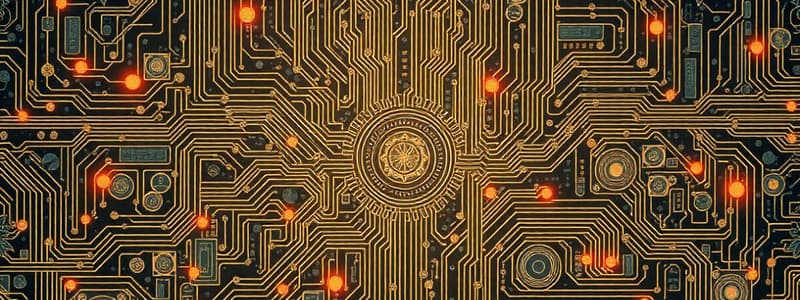Podcast
Questions and Answers
What is the primary function of a diode in an analog circuit?
What is the primary function of a diode in an analog circuit?
- Converting AC signals to DC signals (correct)
- Filtering frequency components
- Amplification of signals
- Generating periodic signals
Zener diodes are operated in the forward bias region.
Zener diodes are operated in the forward bias region.
False (B)
Describe the characteristic curve of a diode.
Describe the characteristic curve of a diode.
It shows the relationship between voltage and current.
A ___ rectifier uses multiple diodes to convert AC to DC more efficiently.
A ___ rectifier uses multiple diodes to convert AC to DC more efficiently.
What occurs when the reverse bias voltage exceeds a diode's junction strength?
What occurs when the reverse bias voltage exceeds a diode's junction strength?
What is the role of a light-emitting diode (LED)?
What is the role of a light-emitting diode (LED)?
Match the following types of diodes with their primary use:
Match the following types of diodes with their primary use:
In reverse bias, the diode current is relatively high.
In reverse bias, the diode current is relatively high.
Flashcards
Analog Circuits
Analog Circuits
Analog circuits manipulate signals that change continuously over time, unlike digital circuits that use discrete values. They are ideal for applications requiring high precision and wide dynamic range, commonly found in audio amplifiers and scientific instruments.
Resistors
Resistors
Resistors are fundamental components in analog circuits that regulate the flow of current and control voltage drops. They act as voltage dividers and are essential for setting current values in circuits.
Capacitors
Capacitors
Capacitors store electrical energy and act as filters in analog circuits. They impede changes in voltage and can be used to smooth out signals or block high-frequency components.
Inductors
Inductors
Signup and view all the flashcards
Op-amps
Op-amps
Signup and view all the flashcards
Diodes
Diodes
Signup and view all the flashcards
Rectification
Rectification
Signup and view all the flashcards
Zener Diodes
Zener Diodes
Signup and view all the flashcards
Study Notes
Analog Electronics Circuits
- Analog circuits process continuously varying signals, represented by voltage or current levels that change over time.
- These signals are continuous, not discrete.
- Analog circuits are used in applications needing high precision and wide dynamic range, like audio amplifiers and instrumentation systems.
- Key components include resistors, capacitors, inductors, and operational amplifiers (op-amps).
- Resistors control current flow and voltage drop.
- Capacitors store electrical energy and act as filters.
- Inductors store magnetic energy and are used in resonant circuits.
- Op-amps amplify, filter, and process signals.
- Common configurations include amplifiers, filters, oscillators, and comparators.
- Amplifiers increase input signal amplitude.
- Filters select and modify frequency components of the input signal.
- Oscillators create periodic signals (sine waves, square waves).
- Comparators compare two signals and output a binary value (high or low).
- Analog circuit design considers frequency response, gain, and stability.
- Frequency response shows how the circuit behaves at various frequencies.
- Gain is the circuit's amplification factor.
- Stability ensures consistent performance under varying conditions.
Diode Circuits
- Diodes are semiconductor devices allowing current flow in one direction only.
- This one-way property is crucial in many analog circuits.
- A diode's characteristic curve shows voltage-current relationship.
- Diodes primarily rectify AC signals to DC signals.
- Full-wave rectifiers use more diodes for more efficient AC-to-DC conversion compared to half-wave rectifiers.
- Diodes are used in voltage regulation and clamping circuits.
- Forward voltage drop is small when a diode conducts.
- Reverse bias results in very little diode current.
- Breakdown voltage occurs when reverse bias overcomes junction strength, leading to high reverse current.
- Different diode types have specific characteristics:
- Zener diodes operate in reverse breakdown.
- Light-emitting diodes (LEDs) emit light when forward biased.
- Schottky diodes switch faster than other diodes.
- Diode applications include:
- Rectifiers (AC to DC conversion)
- Voltage clamps (limiting voltage spikes)
- Logic gates (in digital circuits)
- Signal detectors (detecting specific signals)
- Protective circuits (preventing voltage surge damage)
- Diode selection depends on needed application characteristics, like reverse breakdown voltage, current rating, and speed.
- Troubleshooting diode circuits involves checking polarity, continuity, and voltage drops.
Studying That Suits You
Use AI to generate personalized quizzes and flashcards to suit your learning preferences.



